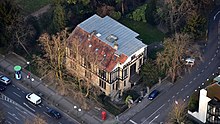Adenauerallee 7 (Bonn)
The building Adenauerallee 7 is a villa in Bonn 's Südstadt district , which was built in 1906/07. It is located on the east side of Adenauerallee ( B 9 ) on the edge of the city garden . The villa stands as a monument under monument protection and is used as an office building today.
history
The villa was built for the client Gustav Ebbinghaus , then curator of the University of Bonn , based on a design by the Berlin architects Kayser & von Großheim , the local representative of which was the architect Heinrich Rings. In 1905, Ebbinghaus owned five houses and outbuildings from the hoteliers Hubert and Jakob Eller, three of which were villas until the end as "Hotel Kley" and two residential buildings were used privately by the hoteliers, in front of Koblenzer Tor on what was then Coblenzerstraße(No. 1–7) with a 16,496 m² plot of land for demolition. He had two villas built there, one for himself (Coblenzerstraße 5) and the other as a rental property for the pensioner Engel (Coblenzerstraße 7). In response to the building application dated January 20, 1906, the building permit for both villas including outbuildings was granted on March 1, 1906 . On October 23, 1906 the building shell was accepted and on September 6, 1907 or shortly before the acceptance test took place . At the same time as the two villas, a garden pavilion was built on the Rhine.
In the early 1920s, both villas built by Ebbinghaus were confiscated by the French occupying forces (as of 1924), after which they fell into the possession of the city of Bonn (as of 1926). While house no. 5 now served as the “city garden building”, house no. 7 was home to a natural history museum with administrators' apartments (as of 1929). The museum only existed until the mid-1930s, so from then on the villa was used exclusively as a residential building. Towards the end of the Second World War , the most devastating of the bombing raids on Bonn in the Allied air war on October 18, 1944, resulted in serious damage to both villas. While the former city garden building was destroyed so much that the ruins collapsed a few years later, today's Villa Adenauerallee 7 was only affected in the roof area. The roof structure burned out completely, but the south gable was preserved.
After the neighboring Hotel Royal had acquired the villa, following a building application from December 22, 1945, an emergency roof was put on according to plans by the local architect Karl Oldag in order to set up a small apartment, staff rooms and three guest rooms on the top floor. The first floor also accommodated hotel rooms. The house was named Grand Hotel Royal. From the end of the 1950s, the city of Bonn, as the owner, used parts of the villa itself as the seat of the tourist office (status: 1965-67) and rented it or provided it to various associations and organizations such as the Institute for SME Research (status: 1958-75 ), the Beautification Association for the Siebengebirge (status: 1967-75), the Bonner Kunstverein (status: 1981) and the German Cultural Council (status: 1989) as well as the "Bonn 2000" project. The longest user since the late 1970s has been the "Oxford-Club Bonn", an association that promotes twinning between Bonn and Oxford . In addition, the villa is now also home to the "Academy for International Education" (AIB) with office and training space and an apartment for lecturers. In October 2010 the villa was finally sold to a lawyer, but it is expected to remain rented to the previous users until at least 2022.
The villa was entered in the city of Bonn's list of monuments on December 16, 1996.
literature
- Olga Sonntag : Villas on the banks of the Rhine in Bonn: 1819–1914 , Bouvier Verlag, Bonn 1998, ISBN 3-416-02618-7 , Volume 3, Catalog (2), pp. 221–226. (also dissertation University of Bonn, 1994)
Web links
References and comments
- ↑ originally Coblenzerstraße 7 , then until 1967 Koblenzer Straße 7
- ↑ List of monuments of the city of Bonn (as of March 15, 2019), number A 3287
- ↑ Olga Sonntag : Villas on the banks of the Rhine in Bonn: 1819–1914 , Bouvier Verlag, Bonn 1998, ISBN 3-416-02618-7 , Volume 2, catalog (1), p. 148 (also dissertation University of Bonn, 1994)
- ↑ initially at Coblenzerstraße 3
- ↑ a b c Address book of the city of Bonn , JF Carthaus, Bonn. (online ULB Bonn : 1908/09 , 1909/10 , 1910/11 , 1924 , 1926 , 1927 , 1929 , 1936 , 1938 , 1939 , 1952/53 , 1958/59 , 1965 , 1967 , 1975 )
- ↑ a b Olga Sonntag: Villas on the banks of the Rhine in Bonn: 1819–1914 , Volume 2, Catalog (3)
- ↑ a b The information is taken from the legally binding list of monuments of the city of Bonn. It is managed by the Lower Monument Authority , from which the entries for the individual monuments can be obtained for a fee.
- ↑ Typically women: Bonner Kunstverein and Galerie Magers 19.9.-1.11.1981 , Bonner Kunstverein, 1981, p. 4.
- ↑ Paperback of public life , 39th edition, Festland Verlag, 1989, p. 949.
- ^ City sells Villa am Hofgarten , General-Anzeiger , October 12, 2010
Coordinates: 50 ° 44 ′ 0.4 ″ N , 7 ° 6 ′ 24.2 ″ E

